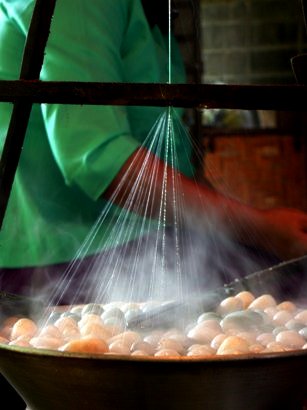
Since evidence for silk production in China can be dated firmly to the Longshan the Yongshan 5000 – 3000 BC, the find of Pakistani silk is indirect evidence for early trade between China and the Indian subcontinent. The Harappan people of the Indus Valley apparently valued silk enough and knew enough about its production to create an early indigenous industry in its manufacture. Until this find, the earliest known production of silk in India was dated to around 1500 BC – so this find in the Indus Valley is indeed significant.
The Harappan silks seem to have been made by a process called reeling, in which the strands are collected on a bobbin (more like a wool spinning process) rather than being twisted in short segments into a thread. This produced a coarser, looser and lighter weave than that which is characteristic of Chinese silk.
It is fascinating to speculate about what fueled the origins of this native Pakistani industry. Were the prices for the Chinese silk too high? Were traders visits unscheduled and unreliable? Did Chinese manufacture or weaving technologies change to produce a silk that was in some way unappealing to the Harappans? So many questions.
Silks and knowledge of its production flowed over the Silk Road as did other elements of culture – beliefs, social customs, as well as food, ingredients and methods of preparation. In this earlier period of globalization, the Silk Roads were the great information highways of their day.
Words by Laura Kelley; Photo of Cooking Silk Worm Coccoons by Snappahed| Dreamstime.com; Special thanks to Shannon F for sending the article to me.
